FIAT BRAVO 2013 2.G Owners Manual
Manufacturer: FIAT, Model Year: 2013, Model line: BRAVO, Model: FIAT BRAVO 2013 2.GPages: 299, PDF Size: 5.86 MB
Page 241 of 299
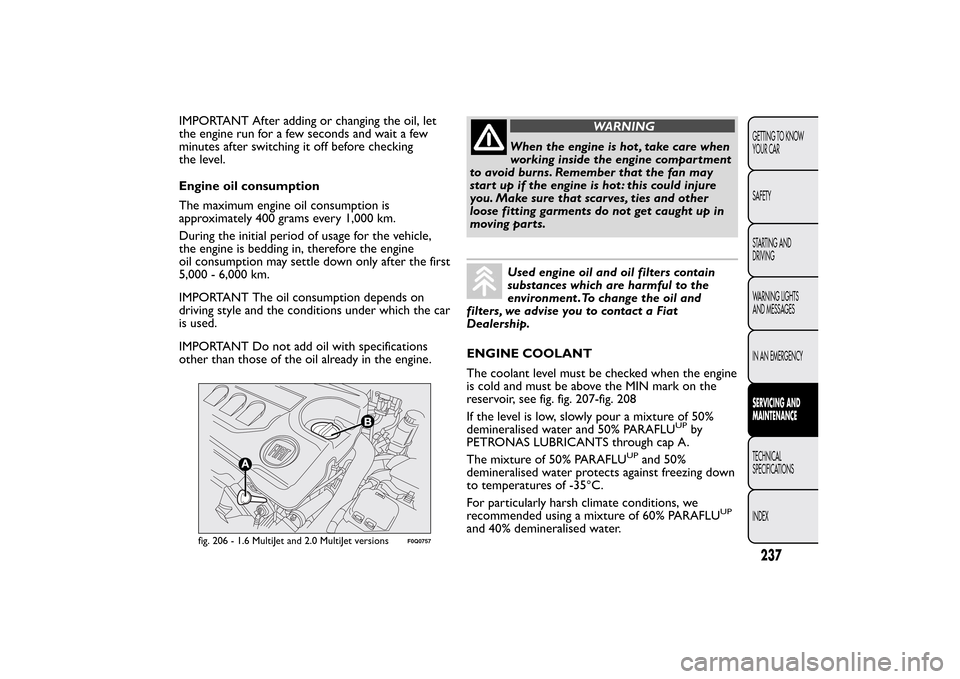
IMPORTANT After adding or changing the oil, let
the engine run for a few seconds and wait a few
minutes after switching it off before checking
the level.
Engine oil consumption
The maximum engine oil consumption is
approximately 400 grams every 1,000 km.
During the initial period of usage for the vehicle,
the engine is bedding in, therefore the engine
oil consumption may settle down only after the first
5,000 - 6,000 km.
IMPORTANT The oil consumption depends on
driving style and the conditions under which the car
is used.
IMPORTANT Do not add oil with specifications
other than those of the oil already in the engine.
WARNING
When the engine is hot , take care when
working inside the engine compartment
to avoid burns. Remember that the fan may
start up if the engine is hot : this could injure
you. Make sure that scarves, ties and other
loose fitting garments do not get caught up in
moving parts.Used engine oil and oil filters contain
substances which are harmful to the
environment .To change the oil and
filters, we advise you to contact a Fiat
Dealership.
ENGINE COOLANT
The coolant level must be checked when the engine
is cold and must be above the MIN mark on the
reservoir, see fig. fig. 207-fig. 208
If the level is low, slowly pour a mixture of 50%
demineralised water and 50% PARAFLU
UP
by
PETRONAS LUBRICANTS through cap A.
The mixture of 50% PARAFLU
UP
and 50%
demineralised water protects against freezing down
to temperatures of -35°C.
For particularly harsh climate conditions, we
recommended using a mixture of 60% PARAFLU
UP
and 40% demineralised water.
fig. 206 - 1.6 MultiJet and 2.0 MultiJet versions
F0Q0757
237GETTING TO KNOW
YOUR CAR
SAFETY
STARTING AND
DRIVING
WARNING LIGHTS
AND MESSAGES
IN AN EMERGENCYSERVICING AND
MAINTENANCETECHNICAL
SPECIFICATIONS
INDEX
Page 242 of 299
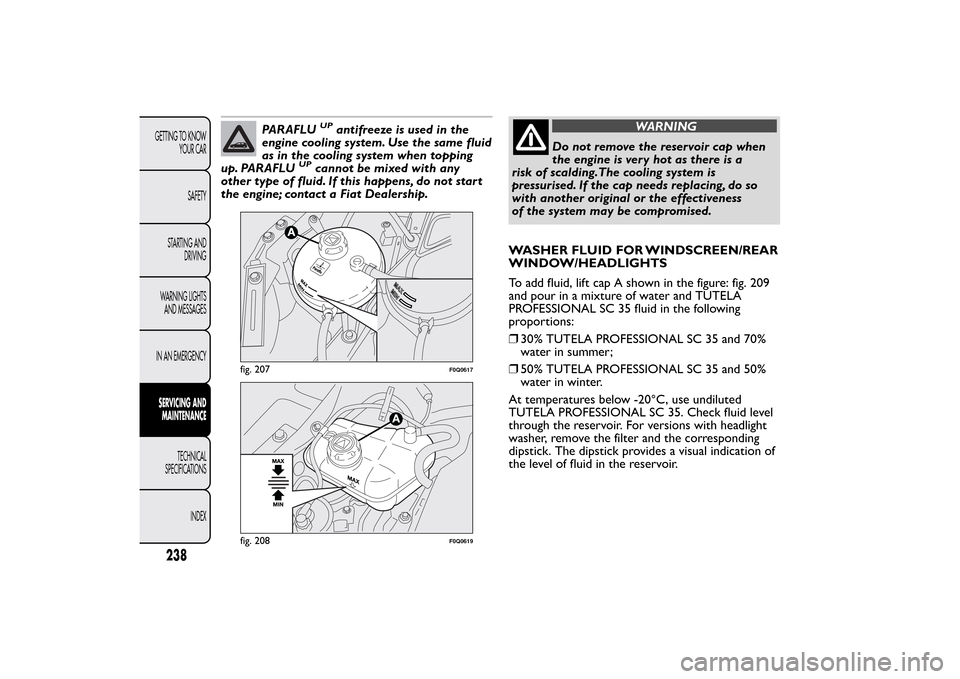
PARAFLU
UP
antifreeze is used in the
engine cooling system. Use the same fluid
as in the cooling system when topping
up. PARAFLU
UP
cannot be mixed with any
other type of fluid. If this happens, do not start
the engine; contact a Fiat Dealership.
WARNING
Do not remove the reservoir cap when
the engine is very hot as there is a
risk of scalding.The cooling system is
pressurised. If the cap needs replacing, do so
with another original or the effectiveness
of the system may be compromised.
WASHER FLUID FOR WINDSCREEN/REAR
WINDOW/HEADLIGHTS
To add fluid, lift cap A shown in the figure: fig. 209
and pour in a mixture of water and TUTELA
PROFESSIONAL SC 35 fluid in the following
proportions:
❒30% TUTELA PROFESSIONAL SC 35 and 70%
water in summer;
❒50% TUTELA PROFESSIONAL SC 35 and 50%
water in winter.
At temperatures below -20°C, use undiluted
TUTELA PROFESSIONAL SC 35. Check fluid level
through the reservoir. For versions with headlight
washer, remove the filter and the corresponding
dipstick. The dipstick provides a visual indication of
the level of fluid in the reservoir.
fig. 207
F0Q0617
fig. 208
F0Q0619
238GETTING TO KNOW
YOUR CAR
SAFETY
STARTING AND
DRIVING
WARNING LIGHTS
AND MESSAGES
IN AN EMERGENCYSERVICING AND
MAINTENANCE
TECHNICAL
SPECIFICATIONS
INDEX
Page 243 of 299
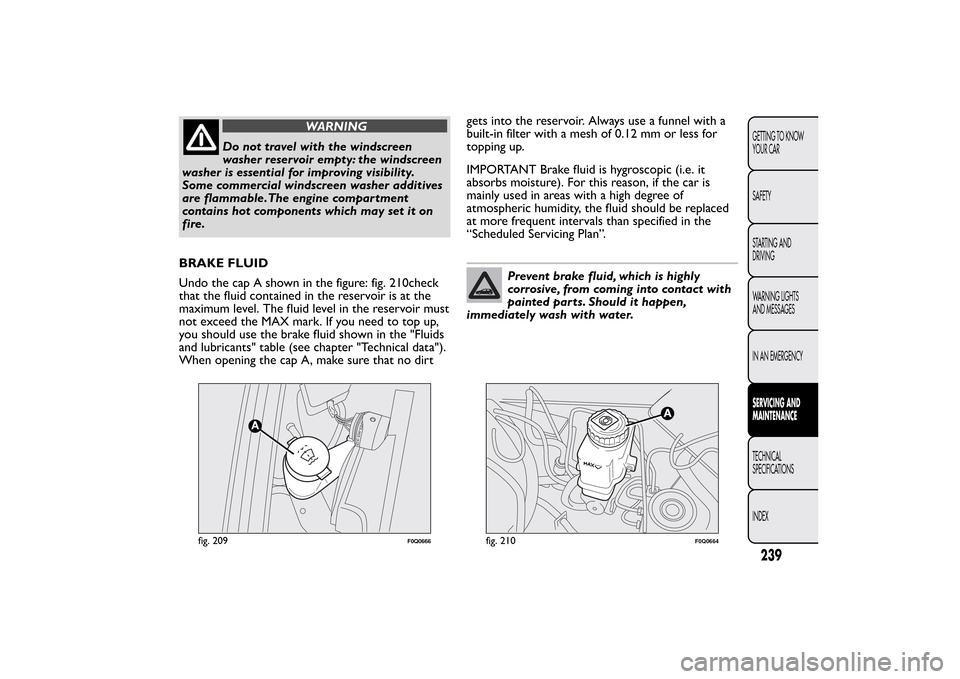
WARNING
Do not travel with the windscreen
washer reservoir empty: the windscreen
washer is essential for improving visibility.
Some commercial windscreen washer additives
are flammable.The engine compartment
contains hot components which may set it on
fire.
BRAKE FLUID
Undo the cap A shown in the figure: fig. 210check
that the fluid contained in the reservoir is at the
maximum level. The fluid level in the reservoir must
not exceed the MAX mark. If you need to top up,
you should use the brake fluid shown in the "Fluids
and lubricants" table (see chapter "Technical data").
When opening the cap A, make sure that no dirtgets into the reservoir. Always use a funnel with a
built-in filter with a mesh of 0.12 mm or less for
topping up.
IMPORTANT Brake fluid is hygroscopic (i.e. it
absorbs moisture). For this reason, if the car is
mainly used in areas with a high degree of
atmospheric humidity, the fluid should be replaced
at more frequent intervals than specified in the
“Scheduled Servicing Plan”.
Prevent brake fluid, which is highly
corrosive, from coming into contact with
painted parts. Should it happen,
immediately wash with water.
fig. 209
F0Q0666
fig. 210
F0Q0664
239GETTING TO KNOW
YOUR CAR
SAFETY
STARTING AND
DRIVING
WARNING LIGHTS
AND MESSAGES
IN AN EMERGENCYSERVICING AND
MAINTENANCETECHNICAL
SPECIFICATIONS
INDEX
Page 244 of 299
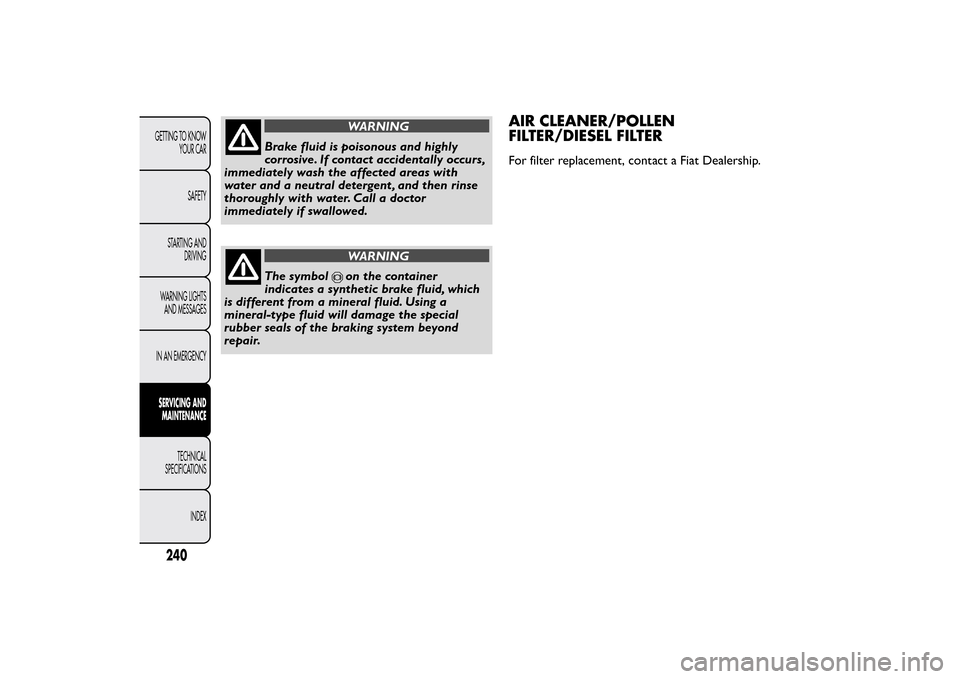
WARNING
Brake fluid is poisonous and highly
corrosive. If contact accidentally occurs,
immediately wash the affected areas with
water and a neutral detergent , and then rinse
thoroughly with water. Call a doctor
immediately if swallowed.
WARNING
The symbol
on the container
indicates a synthetic brake fluid, which
is different from a mineral fluid. Using a
mineral-type fluid will damage the special
rubber seals of the braking system beyond
repair.
AIR CLEANER/POLLEN
FILTER/DIESEL FILTERFor filter replacement, contact a Fiat Dealership.
240GETTING TO KNOW
YOUR CAR
SAFETY
STARTING AND
DRIVING
WARNING LIGHTS
AND MESSAGES
IN AN EMERGENCYSERVICING AND
MAINTENANCE
TECHNICAL
SPECIFICATIONS
INDEX
Page 245 of 299
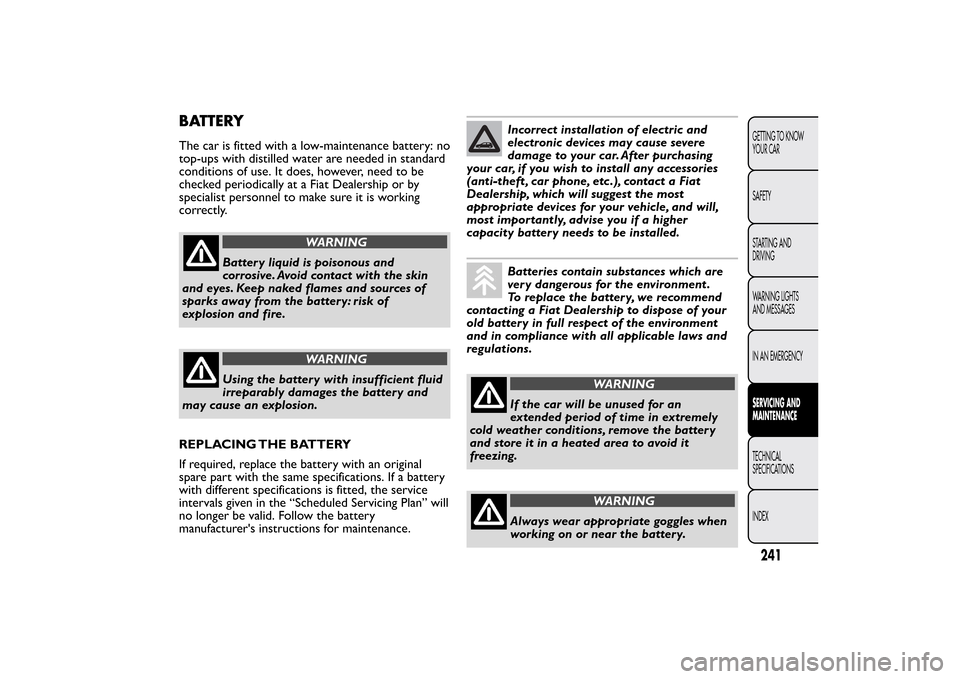
BATTERYThe car is fitted with a low-maintenance battery: no
top-ups with distilled water are needed in standard
conditions of use. It does, however, need to be
checked periodically at a Fiat Dealership or by
specialist personnel to make sure it is working
correctly.
WARNING
Battery liquid is poisonous and
corrosive. Avoid contact with the skin
and eyes. Keep naked flames and sources of
sparks away from the battery: risk of
explosion and fire.
WARNING
Using the battery with insufficient fluid
irreparably damages the battery and
may cause an explosion.
REPLACING THE BATTERY
If required, replace the battery with an original
spare part with the same specifications. If a battery
with different specifications is fitted, the service
intervals given in the “Scheduled Servicing Plan” will
no longer be valid. Follow the battery
manufacturer's instructions for maintenance.
Incorrect installation of electric and
electronic devices may cause severe
damage to your car. After purchasing
your car, if you wish to install any accessories
(anti-theft , car phone, etc .), contact a Fiat
Dealership, which will suggest the most
appropriate devices for your vehicle, and will,
most importantly, advise you if a higher
capacity batter y needs to be installed.Batteries contain substances which are
ver y dangerous for the environment .
To replace the battery, we recommend
contacting a Fiat Dealership to dispose of your
old battery in full respect of the environment
and in compliance with all applicable laws and
regulations.
WARNING
If the car will be unused for an
extended period of time in extremely
cold weather conditions, remove the battery
and store it in a heated area to avoid it
freezing.
WARNING
Always wear appropriate goggles when
working on or near the battery.
241GETTING TO KNOW
YOUR CAR
SAFETY
STARTING AND
DRIVING
WARNING LIGHTS
AND MESSAGES
IN AN EMERGENCYSERVICING AND
MAINTENANCETECHNICAL
SPECIFICATIONS
INDEX
Page 246 of 299
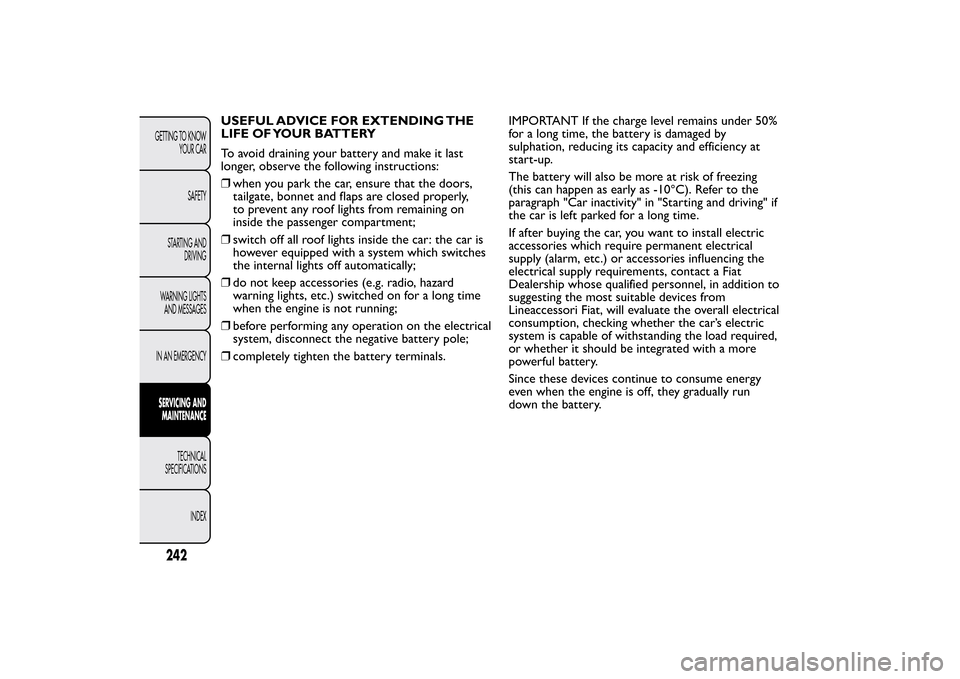
USEFUL ADVICE FOR EXTENDING THE
LIFE OF YOUR BATTERY
To avoid draining your battery and make it last
longer, observe the following instructions:
❒when you park the car, ensure that the doors,
tailgate, bonnet and flaps are closed properly,
to prevent any roof lights from remaining on
inside the passenger compartment;
❒switch off all roof lights inside the car: the car is
however equipped with a system which switches
the internal lights off automatically;
❒do not keep accessories (e.g. radio, hazard
warning lights, etc.) switched on for a long time
when the engine is not running;
❒before performing any operation on the electrical
system, disconnect the negative battery pole;
❒completely tighten the battery terminals.IMPORTANT If the charge level remains under 50%
for a long time, the battery is damaged by
sulphation, reducing its capacity and efficiency at
start-up.
The battery will also be more at risk of freezing
(this can happen as early as -10°C). Refer to the
paragraph "Car inactivity" in "Starting and driving" if
the car is left parked for a long time.
If after buying the car, you want to install electric
accessories which require permanent electrical
supply (alarm, etc.) or accessories influencing the
electrical supply requirements, contact a Fiat
Dealership whose qualified personnel, in addition to
suggesting the most suitable devices from
Lineaccessori Fiat, will evaluate the overall electrical
consumption, checking whether the car’s electric
system is capable of withstanding the load required,
or whether it should be integrated with a more
powerful battery.
Since these devices continue to consume energy
even when the engine is off, they gradually run
down the battery.
242GETTING TO KNOW
YOUR CAR
SAFETY
STARTING AND
DRIVING
WARNING LIGHTS
AND MESSAGES
IN AN EMERGENCYSERVICING AND
MAINTENANCE
TECHNICAL
SPECIFICATIONS
INDEX
Page 247 of 299
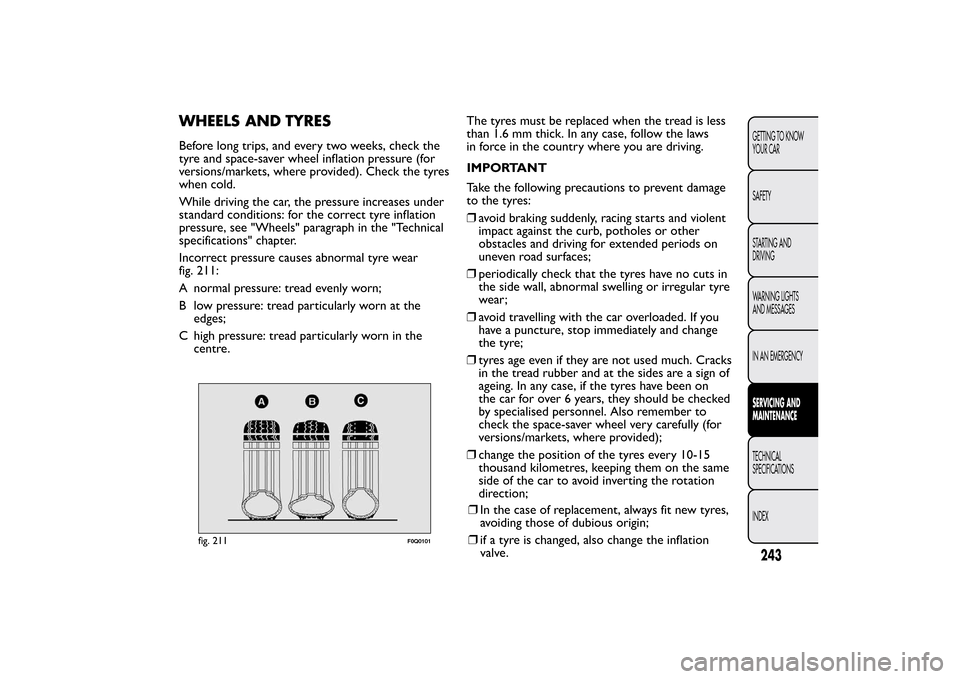
WHEELS AND TYRESBefore long trips, and every two weeks, check the
tyre and space-saver wheel inflation pressure (for
versions/markets, where provided). Check the tyres
when cold.
While driving the car, the pressure increases under
standard conditions: for the correct tyre inflation
pressure, see "Wheels" paragraph in the "Technical
specifications" chapter.
Incorrect pressure causes abnormal tyre wear
fig. 211:
A normal pressure: tread evenly worn;
B low pressure: tread particularly worn at the
edges;
C high pressure: tread particularly worn in the
centre.The tyres must be replaced when the tread is less
than 1.6 mm thick. In any case, follow the laws
in force in the country where you are driving.
IMPORTANT
Take the following precautions to prevent damage
to the tyres:
❒avoid braking suddenly, racing starts and violent
impact against the curb, potholes or other
obstacles and driving for extended periods on
uneven road surfaces;
❒periodically check that the tyres have no cuts in
the side wall, abnormal swelling or irregular tyre
wear;
❒avoid travelling with the car overloaded. If you
have a puncture, stop immediately and change
the tyre;
❒tyres age even if they are not used much. Cracks
in the tread rubber and at the sides are a sign of
ageing. In any case, if the tyres have been on
the car for over 6 years, they should be checked
by specialised personnel. Also remember to
check the space-saver wheel very carefully (for
versions/markets, where provided);
❒change the position of the tyres every 10-15
thousand kilometres, keeping them on the same
side of the car to avoid inverting the rotation
direction;
fig. 211
F0Q0101
243GETTING TO KNOW
YOUR CAR
SAFETY
STARTING AND
DRIVING
WARNING LIGHTS
AND MESSAGES
IN AN EMERGENCYSERVICING AND
MAINTENANCETECHNICAL
SPECIFICATIONS
INDEX
❒In the case of replacement, always fit new tyres,
avoiding those of dubious origin;
❒if a tyre is changed, also change the inflation
valve.
Page 248 of 299
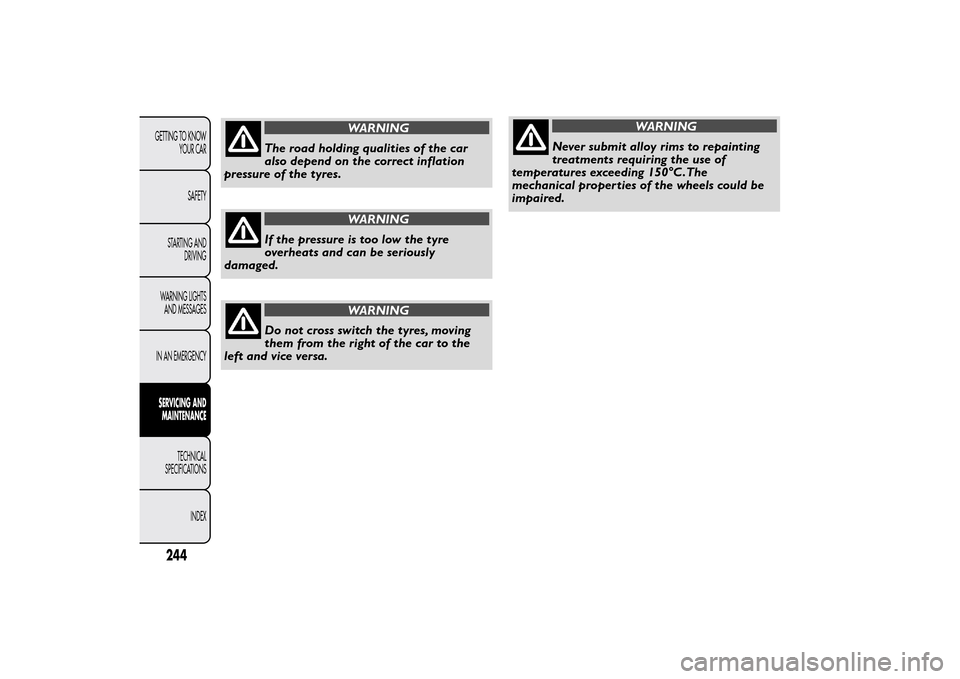
WARNING
The road holding qualities of the car
also depend on the correct inflation
pressure of the tyres.
WARNING
If the pressure is too low the tyre
overheats and can be seriously
damaged.
WARNING
Do not cross switch the tyres, moving
them from the right of the car to the
left and vice versa.
WARNING
Never submit alloy rims to repainting
treatments requiring the use of
temperatures exceeding 150°C.The
mechanical properties of the wheels could be
impaired.
244GETTING TO KNOW
YOUR CAR
SAFETY
STARTING AND
DRIVING
WARNING LIGHTS
AND MESSAGES
IN AN EMERGENCYSERVICING AND
MAINTENANCE
TECHNICAL
SPECIFICATIONS
INDEX
Page 249 of 299

WINDSCREEN/REAR WINDOW
WIPERBLADES
Periodically clean the rubber part using special
products; TUTELA PROFESSIONAL SC 35 is
recommended.
Replace the blades if the rubber edge is deformed
or worn. In any case, it is advisable to replace them
approximately once a year. A few simple
precautions can reduce the possibility of damage to
the blades:
❒if the temperature falls below zero, make sure
that ice has not frozen the rubber against the
glass. Use an antifreeze product to release it
if required;
❒remove any snow from the glass: in addition to
protecting the blades, this prevents effort on
the motor and overheating;
❒do not operate the windscreen/rear window
wipers on dry glass.
WARNING
Driving with worn windscreen/rear
window wiper blades is a serious
hazard, because visibility is reduced in bad
weather.Replacing the wiper blades
Proceed as follows:
❒lift up the windscreen wiper arm and position the
blade so that it forms a 90° angle with the arm;
❒press tab A fig. 212 of the coupling spring and
remove the blade to be replaced from the arm;
❒fit the new blade by inserting the tab into the
special slot in the arm. Make sure that the new
blade is secured in position.
fig. 212
F0Q0662
245GETTING TO KNOW
YOUR CAR
SAFETY
STARTING AND
DRIVING
WARNING LIGHTS
AND MESSAGES
IN AN EMERGENCYSERVICING AND
MAINTENANCETECHNICAL
SPECIFICATIONS
INDEX
Page 250 of 299
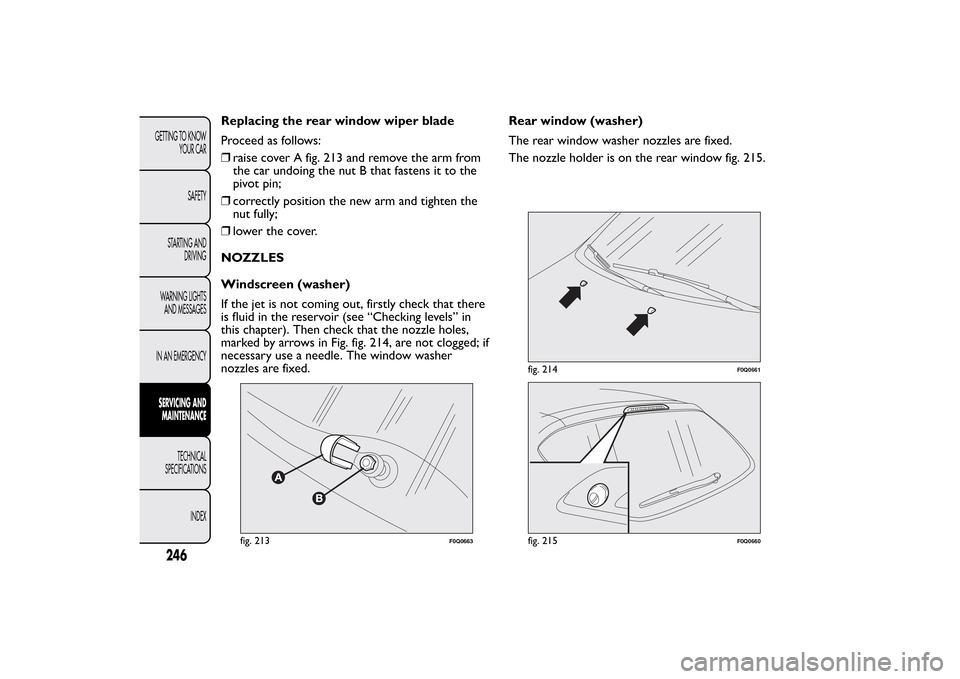
Replacing the rear window wiper blade
Proceed as follows:
❒raise cover A fig. 213 and remove the arm from
the car undoing the nut B that fastens it to the
pivot pin;
❒correctly position the new arm and tighten the
nut fully;
❒lower the cover.
NOZZLES
Windscreen (washer)
If the jet is not coming out, firstly check that there
is fluid in the reservoir (see “Checking levels” in
this chapter). Then check that the nozzle holes,
marked by arrows in Fig. fig. 214, are not clogged; if
necessary use a needle. The window washer
nozzles are fixed.Rear window (washer)
The rear window washer nozzles are fixed.
The nozzle holder is on the rear window fig. 215.
fig. 213
F0Q0663
fig. 214
F0Q0661
fig. 215
F0Q0660
246GETTING TO KNOW
YOUR CAR
SAFETY
STARTING AND
DRIVING
WARNING LIGHTS
AND MESSAGES
IN AN EMERGENCYSERVICING AND
MAINTENANCE
TECHNICAL
SPECIFICATIONS
INDEX